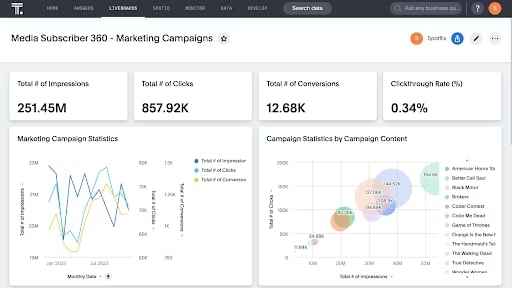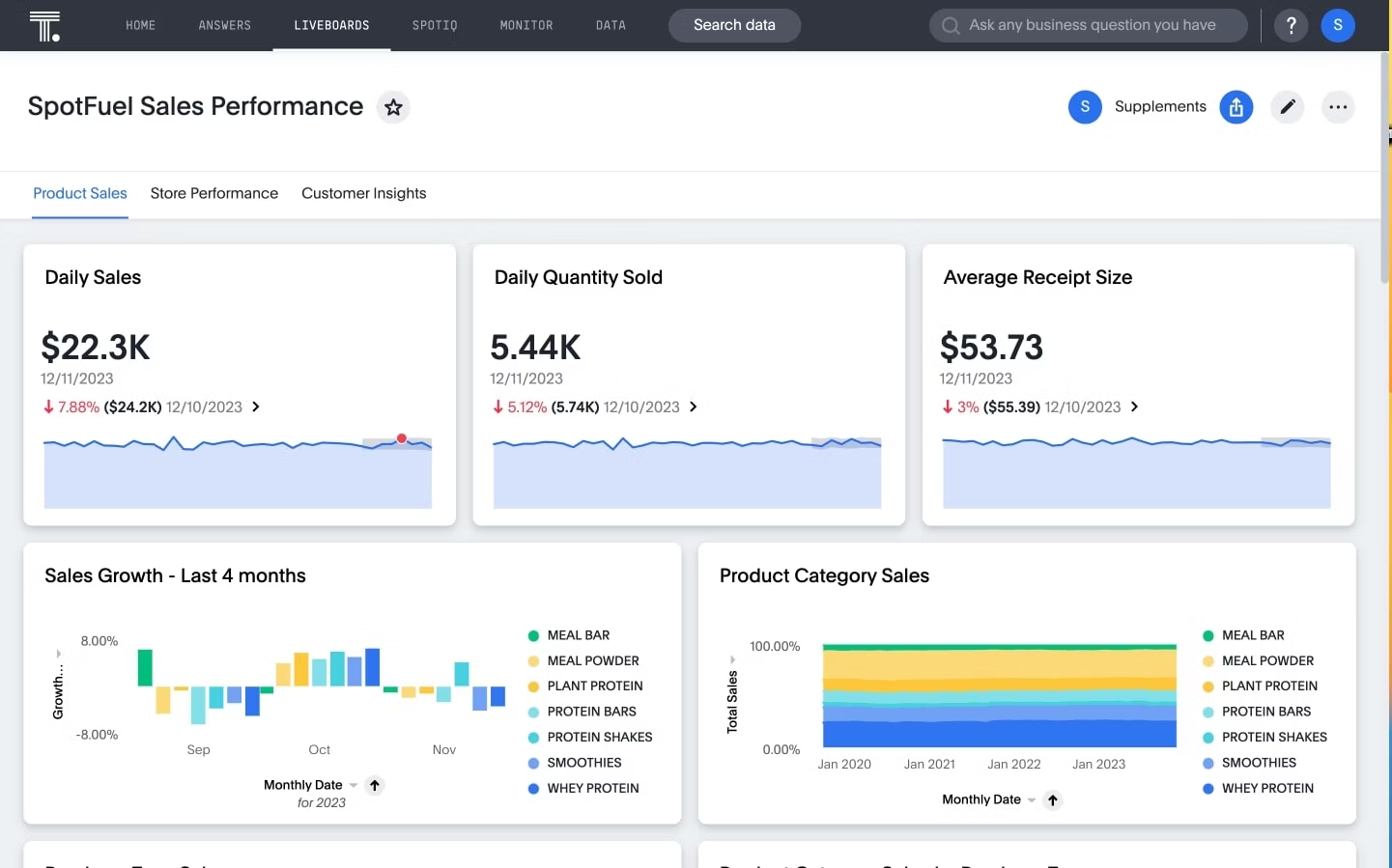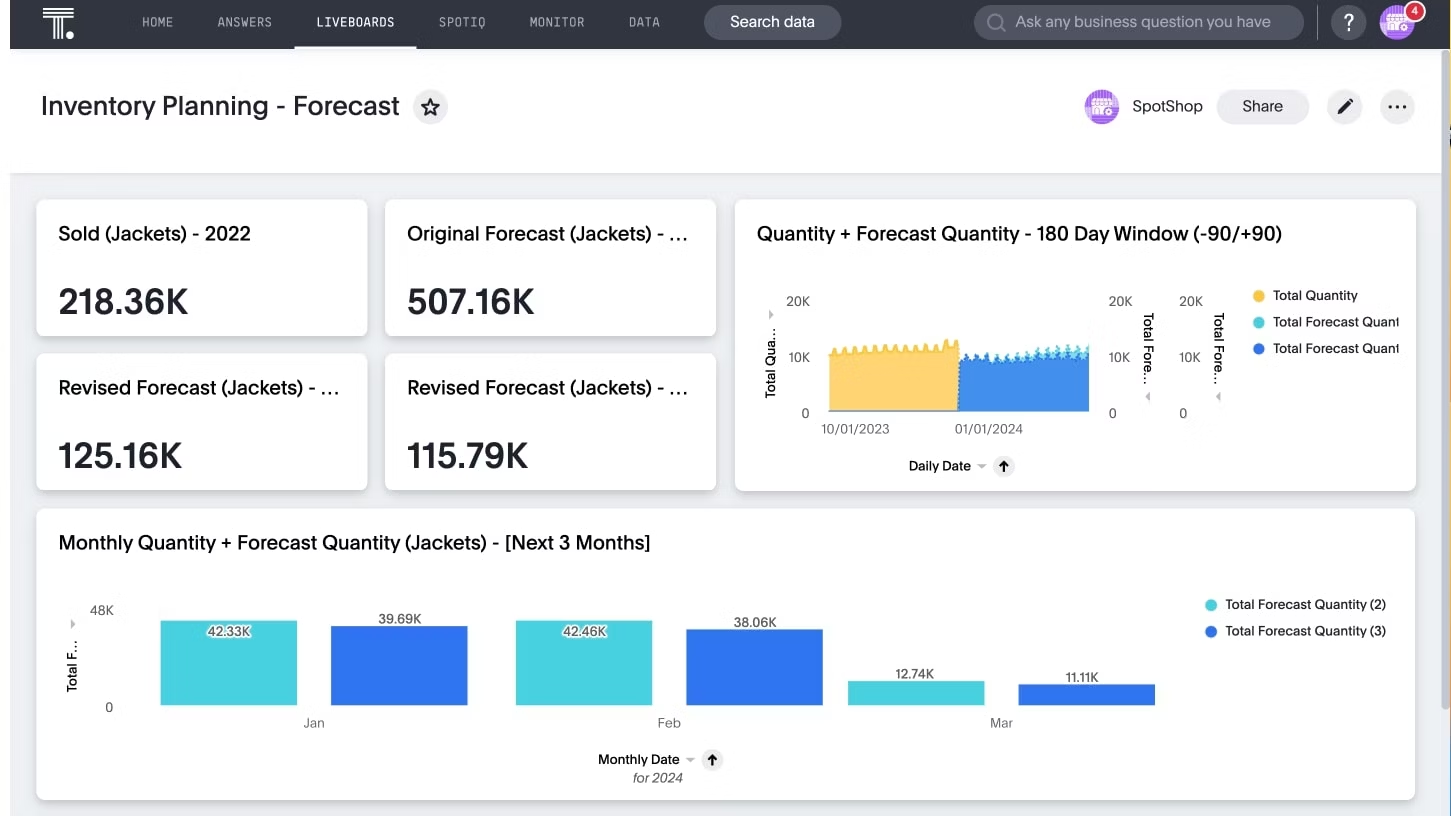Business moves fast, and today’s leaders are expected to keep up with new opportunities, shifting priorities, and rising expectations. But without clear, timely insight into what’s actually happening across the organization, it’s easy to lose momentum or miss the mark entirely.
Leaders don’t need more data—they need the right data, at the right time. Executive dashboards surface real-time key performance indicators (KPIs) in one place, giving decision-makers the clarity to move quickly and confidently.
In this article, you’ll see what makes an executive dashboard useful, why it matters, and how top organizations are putting them to work.
Table of Contents:
An executive dashboard is a visual tool that lets you track KPIs and monitor overall business performance at a glance.
It pulls data from across your business intelligence platform and presents it through easy-to-digest charts, graphs, and tables, so you can quickly make sense of complex information. With real-time tracking, these dashboards help leaders spot trends, respond to issues, and make timely decisions.
For example, finance leaders might use an executive dashboard to keep tabs on finance metrics like revenue growth, current ratio, and ROI to understand financial health and surface areas that need attention.
Now that we’ve covered what executive dashboards do, let’s jump into some real examples. These should give you practical ideas for building your own dashboards—and show how Liveboards can help turn static reports into dynamic insight engines.
1. CEO dashboard
Executive dashboards for CEOs primarily focus on KPIs that directly align with the organization's strategic objectives and long-term goals. While there is no one-size-fits-all template for a CEO dashboard, it often highlights sales performance metrics or summarizes the progress of key initiatives. Here are some of the top metrics of a CEO dashboard:
Geographic performance: Performance metrics across different regions
Lead generation metrics: Effectiveness of lead generation efforts, including the number of leads generated
Gross profit margin: Percentage of revenue remaining after deducting the cost of goods sold
Take a look at this executive dashboard example for the CEO:

2. CMO dashboard
Most CMOs use executive dashboards to get a high-level view of ongoing campaigns and monitor customer behavior. By analyzing marketing efforts, CMOs can improve customer experience across channels and find new cross-selling opportunities. A CMO’s dashboard may include the following metrics:
Conversion rate: Percentage of visitors who turned into actual customers
Customer lifecycle value (CLV): The predicted value a customer will generate throughout their entire relationship with the company
Campaign ROI: Return on investment from specific marketing campaigns
Take a look at this executive dashboard example for the CMO:

3. CFO dashboard
CFOs rely on dashboards to monitor the company’s financial health. Executive dashboards with interactive visualizations of transactional data allow CFOs to get insights into the company’s profitability. CFO dashboards help these leaders compare expected results with actual results and identify areas of improvement. The most common metrics and KPIs in a CFO’s executive dashboard include:
Total revenue: Overall revenue generated by the organization to date
Net profit: Total income after deducting all expenses
Growth of total asset value: Show the growth in the overall value of assets
Take a look at this executive dashboard example for the CFO:

4. COO dashboard
COOs oversee the daily mechanics of the business, from supply chains to production workflows. They need a real-time view of operations to spot inefficiencies, monitor performance, and keep things running at scale. Real-time dashboards help them stay ahead by turning operational data into clear, actionable insight. Common COO metrics include:
Inventory levels: The total quantity of goods or raw materials in stock
Cycle time: The time it takes to complete a specific process or task
Order fulfillment time: The time taken to fulfill customer orders from placement to delivery
Take a look at this executive dashboard example for the COO:

5. CRO dashboard
CROs want insights that help them monitor all revenue-related activities, from marketing to sales and finance. With an executive dashboard, CROs can quickly visualize high-level sales and finance KPIs or drill into specific data around revenue and cost centers to support data-driven decision-making. Here are some of the top metrics a CRO dashboard has:
Customer lifetime value (CLV): Represents the total predicted revenue a customer may generate over their entire relationship
Retention rate: Measures the percentage of customers who continue to remain engaged with the business
Sales cycle time: The total time duration it takes to complete the sales process
Take a look at this executive dashboard example for the CRO:

However, traditional dashboards often fall short. Data can be outdated, fragmented, or lack interactivity, which leads to incomplete or inaccurate insights. That’s why many modern businesses are turning to AI-augmented dashboards that provide better visibility. Here are some of the top benefits:
1. Capturing fragmented insights
Research by Gartner shows that only 14% of organizations have a 360-degree view of their customer. That leaves most companies flying blind, unable to fully capitalize on the data they already have.
Liveboards solve this by bringing together data from spreadsheets, cloud apps, and external APIs to create a single, connected view. By capturing fragmented insights that would otherwise stay siloed, you can factor in all the variables for critical decisions.
2. Revealing trends and patterns
Beyond providing instant access to real-time insights, executive dashboards let you interact deeply with charts and graphs through drill-downs and filters. This granularity helps you see subtle relationships and hidden trends that might otherwise go unnoticed.
That’s exactly what happened at T-Mobile Netherlands. What used to take weeks to configure now takes just 90 minutes, helping them save over €1 million in data costs.
Their secret? ThoughtSpot’s AI-augmented dashboards. Here’s what Hermen Geerts, former Product Owner BI at T-Mobile Netherlands, had to say about the company’s experience using ThoughtSpot:
“Specialist, highly-trained analysts are now free to help us meet our most strategic challenges. We’ve estimated that we’re saving in the region of €1 million annually by freeing up at least 40 days a month in data analyst time, along with outsourced IT costs.”
3. Aligning data with business strategy
Executive dashboards help you spot shifts in data and market trends quickly, so you can tweak your strategies on the fly. When you get a clear, full picture of how the business is performing, it’s easier to spot new opportunities and figure out what to fix.
Take Fabuwood, for example. With ThoughtSpot’s self-service Liveboards, their execs could jump into live sales data in Databricks right away, no waiting around.
Here’s what David Samet, Fabuwood’s Director of Technology, had to say about ThoughtSpot’s Liveboards:
“With ThoughtSpot, I appreciated that drill down was readily available. It could take up to a week to build each additional ad-hoc report. So, the fact that drill down works with live data, and goes from the most aggregate level all the way down to the most detailed level—that was definitely an ah-ha moment for me..And there’s an ah-ha moment each time a new user gets it.”
You don’t need to be a data expert to build an executive business dashboard that delivers real value. But you do need to be intentional about what you include (and leave out), how you structure your data, and who you’re building it for. Here’s a step-by-step guide to get you started:
Step 1: Start with your audience
Before diving into metrics, ask: Who will use this dashboard? What decisions are they making, and what data will help them do that faster and more confidently?
A CEO might need a bird's-eye view of revenue and strategy progress.
A CMO might want channel-specific conversion data, fast.
A COO may care more about cycle times and supply chain bottlenecks.
Don’t just guess, talk to them. What do they check every Monday morning? What numbers do they always ask for in meetings?
Step 2: Pick the right KPIs
Executive dashboards aren’t the place for vanity metrics or granular details. Focus on KPIs that tie directly to business goals and outcomes. A few good rules of thumb:
Fewer is better. Aim for 5–10 core metrics per dashboard
Prioritize actionable insights over interesting stats
Where possible, show both leading and lagging indicators
For example, instead of just showing last quarter’s revenue, show pipeline velocity to predict future growth.
Step 3: Connect your data sources
To keep your dashboard fresh and reliable, it needs access to the right data. That might mean connecting your CRM, ERP, marketing tools, or data warehouse.
If you’re using an agentic analytics platform like ThoughtSpot, this process is much simpler. You can connect directly to cloud data platforms like Snowflake or Databricks and start querying live data.
Step 4: Design for usability
Visual clutter is your enemy. A great executive dashboard should be easy to scan and even easier to explore.
Use charts and visuals to make trends obvious
Group related metrics logically (e.g., financials in one section, customer metrics in another)
Prioritize interactivity—leaders should be able to filter, drill down, or pivot the data
Step 5: Test, refine, and keep evolving
A dashboard isn’t a “set it and forget it” artifact. Business goals shift, market conditions change, and stakeholders will always find new questions to ask.
Once your dashboard is live, check in regularly with users:
Are they finding it useful?
Are there new KPIs they need?
Is anything being ignored that could be removed?
If you’re building with a tool like ThoughtSpot, this iteration is faster and easier.
Your dashboard shouldn’t be another checkbox. It should be where decisions happen.
With ThoughtSpot’s Liveboards, you get more than charts. You get a dynamic, AI-powered view into your business that updates as fast as your team needs answers. Drill down, explore, and share insights without waiting on the BI queue.
Don’t settle for dashboards that can’t answer your follow-ups—book a demo and see how Liveboards help your team.
FAQs
What’s the difference between an executive dashboard and a regular dashboard?
A regular dashboard might show operational or team-level data, like daily support tickets or individual campaign performance. Executive dashboards zoom out. They highlight high-impact KPIs tied to strategic goals, giving leadership a unified view of performance across departments.
Which departments benefit most from executive dashboards?
Executive dashboards are useful for any department where leadership needs to make high-stakes, fast decisions. That includes finance, marketing, operations, sales, and product. The key is surfacing metrics that ladder up to business outcomes like revenue, growth, and efficiency, not just team activity.
What are the three layers of dashboards?
Dashboards typically fall into three layers, based on who uses them and what decisions they support:
1. Operational dashboards: Used by frontline teams to track day-to-day performance. These dashboards monitor real-time activity like inventory levels, website uptime, or support tickets. They help teams spot and resolve issues quickly.
2. Tactical dashboards: Built for department managers to track team performance over weeks or months. These dashboards help optimize campaigns, sales processes, or supply chains by highlighting trends and areas for improvement.
3. Strategic dashboards: Designed for executives and business leaders. These high-level dashboards focus on company-wide KPIs tied to long-term goals. They help leaders make faster, more confident decisions.









